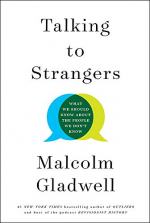|
This section contains 807 words (approx. 3 pages at 400 words per page) |

|
Talking to Strangers: What We Should Know About the People We Don't Know Summary & Study Guide Description
Talking to Strangers: What We Should Know About the People We Don't Know Summary & Study Guide includes comprehensive information and analysis to help you understand the book. This study guide contains the following sections:
This detailed literature summary also contains Topics for Discussion on Talking to Strangers: What We Should Know About the People We Don't Know by Malcolm Gladwell.
The following version of this book was used to create the guide: Gladwell, Malcolm. Talking to Strangers: What We Should Know About the People We Don't Know. Little, Brown and Company, 2019.
Malcolm Gladwell's Talking to Strangers is divided into five parts. The five parts include a total of 12 titled chapters. Each chapter is parceled into smaller numerical sections, which create a compare and contrast mode of argumentation.
In the introduction, "Step out of the car!," Gladwell presents an overview of Sandra Bland and Texas State Trooper's encounter on a Prairie View roadside in July of 2015. Having just moved to town from Illinois, Bland was unfamiliar with her new surroundings. Noticing her out-of-state plates, Encinia grew suspicious. When she failed to signal, he pulled her over. Their interaction grew volatile, ending in Encinia forcefully ripping her from the car, calling for backup, and arresting her. Bland committed suicide in jail three days later. Gladwell says Talking to Strangers is a work interested in understanding what actually went wrong in Bland and Encinia's interaction.
In Part 1: "Spies and Diplomats: Two Puzzles," Gladwell examines two stories, one involving Fidel Castro, the other, Adolf Hitler. After double agent Florentino Aspillaga defected, he gave information to a CIA agent. He revealed that innumerable spies working for the U.S. government were also working for Castro. No one could believe that the most powerful intelligence agency in the world had been tricked. In the second story, after Hitler threatened to invade the Sudetenland, British prime minister Neville Chamberlain swore he could convince him otherwise. After several meetings, Chamberlain announced his belief in Hitler's honesty and trustworthiness. He was tricked, however, and Hitler invaded anyway, breaking their agreement. Gladwell uses these examples to wonder why humans have so much trouble knowing when they are being lied to.
In Part 2: "Default to Truth," Gladwell introduces psychologist Tim Levine's Truth-Default Theory. Levine's studies conclude that people generally believe those they interact with are honest. Gladwell suggests that in order to disbelieve someone, to doubt their authenticity, or to perceive their guilt, the individual must have a significant amount of reason. Belief and doubt, he shows in this section, are deeply entwined. Through examinations of double agent Ana Montes's, and sexual abusers Jerry Sandusky and Larry Nassar's stories, Gladwell illustrates the way this theory occurs in the real world. Because no one wanted to believe that Montes, Sandusky and Nassar were guilty, they dismissed allegations against them.
In Part 3: "Transparency," Gladwell summarizes a Friends episode to introduce the idea of transparency. When watching the popular sitcom, Gladwell says, it is easy to track what is going on by the actors' facial expressions. Their emotions appear transparently on their faces, and in their physical movements. This, however, is not always true to the way humans behavior. Through further examination of Levine's theories, and ancillary anthropological and psychological studies, Gladwell says that humans struggle to understand people whose behaviors do not easily match or parallel their authentic interiors. He then describes Amanda Knox's story by way of example. While studying abroad in Italy, Knox's roommate was murdered. In the days following her attack, friends and law enforcement officers noticed Knox's strange behavior. She was not acting the way they thought she should, and concluded she was guilty. Gladwell says because Knox's emotions were not transparent, no one wanted to believe she was innocent.
In Part 4: "Lessons," Gladwell considers the capture and interrogation of Al Qaeda official Khalid Sheikh Mohammed, or KSM. Because KSM was known for his participation in the 9/11 attacks, CIA agents were eager to discover his secrets, terrified of another attack against the U.S. Interrogators, therefore, used a range of the most severe torture methods to attempt extracting information from him. Gladwell then examines the Air Force's SERE program, which forces students to undergo torture as practice for potential capture. The students' responses were so severe, Gladwell said they could not even answer basic recall questions afterwards. Perhaps, he suggests, torture does not actually make room for the truth.
In Part 5: "Coupling," Gladwell introduces the idea of coupling through the story of American poet Sylvia Plath. Coupling, or the idea that human behaviors are directly linked to their distinct contextual circumstances, is the reason for Plath's suicide, Gladwell argues. She killed herself because she wanted to, and because she had a readily available means to do so. He reveals the same sort of correlative trends via criminology studies, and law enforcement techniques. These considerations guide the reader back to where Gladwell began: on the Prairie View roadside with Bland and Encinia. In the text's final passages, Gladwell provides further details on both Bland's and Encinia's backgrounds, characters, and particular life and vocational contexts. He argues that Bland and Encinia were unable to imagine the other's context, and thus reacted poorly to one another's behaviors.
Read more from the Study Guide
|
This section contains 807 words (approx. 3 pages at 400 words per page) |

|



